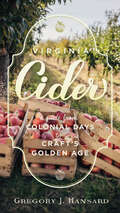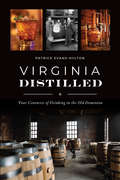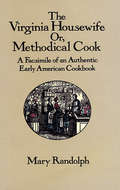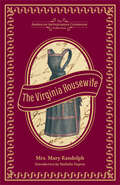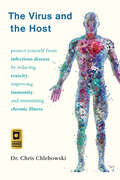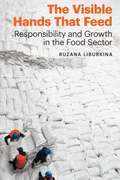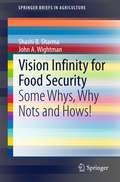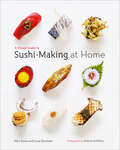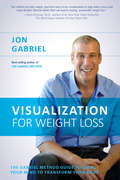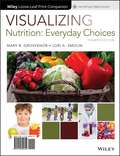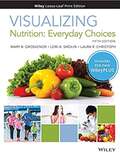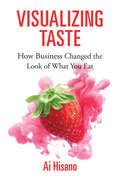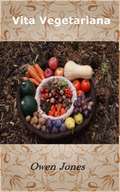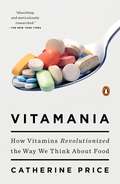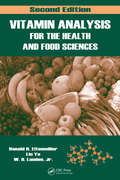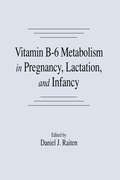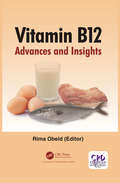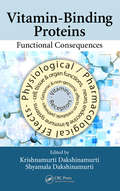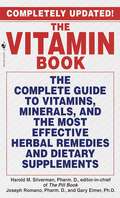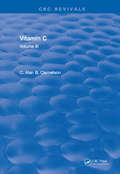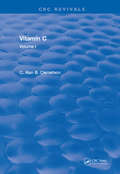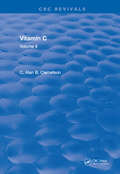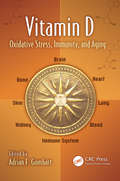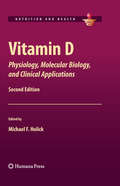- Table View
- List View
Virginia Beer: A Guide from Colonial Days to Craft's Golden Age
by Lee GravesThe days of choosing between a handful of imports and a convenience store six-pack are long gone. The beer landscape in America has changed dramatically in the twenty-first century, as the nation has experienced an explosion in craft beer brewing and consumption. Nowhere is this truer than in Virginia, where more than two hundred independent breweries create beers of an unprecedented variety and serve an increasingly knowledgeable, and thirsty, population of beer enthusiasts. As Lee Graves shows in his definitive new guide to Virginia beer, the Old Dominion’s central role in the current beer boom is no accident. Beer was on board when English settlers landed at Jamestown in 1607, and the taste for beer and expertise in brewing have only grown in the generations since. Graves offers an invaluable survey of key breweries throughout the Virginia, profiling the people and the businesses in each region that have made the state a rising star in the industry. The book is extensively illustrated and suggests numerous brewery tours that will point you in the right direction for your statewide beer crawl. From small farm breweries in the shadow of the Blue Ridge Mountains to cavernous facilities in urban rings around the state, Virginians have created a golden age for flavorful beer. This book shows you how to best appreciate it.
Virginia Cider: A Guide from Colonial Days to Craft's Golden Age
by Gregory J. HansardYour guide to the remarkable history, and ongoing popularity, of cider in the Commonwealth A cultural phenomenon with surprisingly deep roots, cider has been one of Virginia&’s favorite beverages for more than four hundred years, representing a time-honored ingredient of the cultural heritage that the first English settlers brought with them to America. Since the seventeenth century, apple orchards have been a fixture of the farming landscape, and cider was made and consumed by almost everyone—men, women, and children of all socioeconomic orders throughout the state&’s history. Recent decades have witnessed a renaissance of cider culture and cultivation, and today cider-making is a thriving craft-beverage industry, gaining ever-greater numbers of enthusiasts and connoisseurs as more and more cideries spring up every year. An essential title for the Virginian bookshelf, and for all readers interested in American cider: • The definitive history of making and drinking cider in Virginia • An in-depth guide profiling the cideries throughout the state, from Bold Rock to Big Fish, with &“Try This&” suggestions for each location, and a comprehensive map to help plan excursions • Brief descriptions of the varieties of apples preferred by Virginia&’s cider makers • In-depth overviews of everything from Home Cider Making to Laird & Company to Wassail
Virginia Distilled: Four Centuries of Drinking in the Old Dominion (American Palate)
by Patrick Evans-HyltonColonist George Thorpe first crafted "corn beere," an ancestor to bourbon, in 1620 at Berkeley Plantation, and George Washington once operated one of the nation's largest distilleries. Icy mint juleps were first served in Virginia until the state was one of the first to enact Prohibition. That dark period gave rise to bootlegging, moonshining and even NASCAR. Through well-documented research, interviews with key stakeholders and plenty of cocktail recipes for the reader to shake and stir at home, author Patrick Evans-Hylton showcases the rich history of four hundred years of drinking in the Commonwealth. Raise a glass to Virginia, birthplace of American spirits, and its long history of distilling and imbibing.
The Virginia Housewife: A Facsimile of an Authentic Early American Cookbook
by Mary RandolphCharming guide, published in 1824, offers directions for making rabbit soup, beef steak pie, fried calf's feet, shoulder of mutton with celery sauce, leg of pork with pease pudding, pickled oysters, tansey pudding, plum cakes and other culinary treats. Also, household hints for cleaning silver, drying herbs, more.
The Virginia Housewife: Or, Methodical Cook (American Antiquarian Cookbook Collection)
by Mary RandolphThe first regional cookbook published in the United States, this nineteenth century kitchen manual includes recipes, kitchen tips and house management solutions.Published in 1824 in Washington, DC, Virginia Housewife is considered by many culinary historians to be the first real American cookbook, with recipes that originated in American kitchens, leaving behind British traditions, ingredients and methods. Virginia Housewife is also recognized as the nation’s first regional cookbook with a focus on southern-style specialties, some appearing in print for the first time, such as Ochra Soup, Curry of Catfish, Gumbo, Chicken Pudding, Apoquiniminc Cakes. But author Mary Randolph also includes local variations of recipes from the West Indies, New England, Spain, and France, all reflecting the influence of many cuisines on Southern cooking. Diverse offerings include Dough Nuts, Gaspacho, Ropa Vieja, as well as a number of delightful ice cream recipes including, black walnut, quince, pear, citron, and almond. An immediate success, Virginia Housewife was republished at least nineteen times before the Civil War. The Virginia Housewife is also a complete lifestyle reference providing an introduction to the food, culture, and manners of the antebellum South, as well as housekeeping instructions on topics ranging from soap making to herb drying and silver cleaning—everything that a woman of the nineteenth (or the twenty-first) century might desire to know.This facsimile edition of Mary Randolph’s Virginia Housewife was reproduced by permission from the volume in the collection of the American Antiquarian Society, Worcester, Massachusetts, founded in 1812.
The Virus and the Host: Protect Yourself from Infectious Disease by Reducing Toxicity, Improving Immunity, and Minimizing Chronic Illness
by null Chris Chlebowski"A gem of a book at a timely moment in history."—Stephanie Seneff, author of Toxic LegacyLearn how to take control of your health—and decrease susceptibility to infectious viral disease before it strikes.There will almost certainly be more pandemics in our future. Yet, during the coronavirus crisis, not a single major public health official took the simple step of telling Americans what we all need to hear:Robust good health—healthy immunity, low inflammation, low toxic burden, and freedom from stealth infection and chronic disease—is our best defense against infectious viral disease.Of course, it&’s not that simple. The way our bodies interact with infectious disease is complicated—both a function of the &“germ&” and the &“terrain&”—the virus and the host. In The Virus and the Host, Dr. Chlebowski succinctly describes emerging science on the virome and how toxic exposure, chronic inflammation, infections, and chronic diseases interact and predispose us to poor outcomes from acute viral infection. He then clearly outlines the tools needed for better health, including:• How to eat like your life depends on it• The best nutrients to supercharge your immunity• How to harness the power of botanical medicine• How to detoxify simply and safely at home• Valuable information on simple treatment and recommended diagnostic tests for given conditionsAs we move forward from the tragedy of COVID-19, it is essential that we come together to learn from our mistakes, and work hard—and work together—to prevent a similar crisis in the future. When the next pandemic hits, we need to be better prepared. Now is the time to do something, and it is the best investment we can make so that when—not if—the next &“big one&” hits we can keep our loved ones and ourselves safe and healthy. "This book left me feeling optimistic and empowered, and gave me greater knowledge about the history of viruses, as well as their future.&”—Erin Elizabeth, author; public speaker; founder, Health Nut News 2022 Foreword INDIES Book of the Year Award Finalist for Health
The Visible Hands That Feed: Responsibility and Growth in the Food Sector (Our Sustainable Future)
by Ruzana LiburkinaThe Visible Hands That Feed provides crucial insights into the rifts and regularities that are characteristic of today&’s food systems. These insights attend to the widespread disquiet about the ethics and politics of food production and trade. While challenging utopian thinking, these findings give hope by elaborating on the promising nature of what falls between political and moral agendas. In The Visible Hands That Feed Ruzana Liburkina approaches the food sector against the backdrop of its pivotal role for social and ecological relations to trace the potentials and limitations for sustainable change from within. Drawing on the results of ethnographic fieldwork in Europe and South America, Liburkina conducts an in-depth exploration of the practices, visions, concerns, and relationships that unfold at the very locations where food is grown, processed, stored, and served. By scrutinizing two critical notions in relation to sustainability—responsibility and growth—Liburkina offers insights into how sustainable change might be understood and further supported. In this first study of food production and provisioning that is grounded in participant observation in four types of food sector enterprises—farms, food processing companies, foodservice distributors, and public caterers—Liburkina fills an important gap in the literature on sustainable futures by offering detailed and diverse empirical insights into corporate food production and provisioning.
Vision Infinity for Food Security
by Shashi B. Sharma John A. WightmanA new perspective on the global food security situation and highlights the need for seeking a common vision and implementing global planning to define the manner in which the human species will manage its food security. The basic question of 'is there enough food' is examined in general and then in some detail. The history of food production is reviewed in the hope that lessons can be learned from the past. But even after ten thousand years of experience we are not able to feed adequately about a third of our total population, despite what statistics can be made to tell us. Intensive agriculture has stripped out the nutrients that support plant growth and marginalised extensive tracts of land. The global solution to feed the growing population has been and continues to be - produce more food. Even during the last 30 years, about 95 percent of global research investments have focused mainly on increasing productivity. However about a third of the food produced, sufficient to feed over two billion hungry people, is lost or wasted in the food value chain. Climate change is another confounding factor that impinges on our discussions. Pests of all kinds continue to destroy food before and after it is harvested, even though the technology to protect it is available. A huge amount of food is wasted in value chains, particularly at the domestic level. Global food production systems are exposed to unprecedented biosecurity risks posed by invasive harmful organisms and this trend is likely to further exacerbate as current approach to biosecurity is based on the notional premise that lines on maps and the legislation that goes with them is sufficient to halt epidemics. Solutions include extending the number of cultivated plant and animal species to include those that can prosper in what are currently considered to be extreme environments.
A Visual Guide to Sushi-Making at Home
by Hiro Sone Lissa DoumaniFrom the James Beard Award–winning chefs, an all-inclusive, visual handbook for sushi lovers who want to make sushi affordably and confidently at home! This gorgeously accessible book includes popular sushi, sashimi, and sushi-style recipes by the husband-and-wife restaurant team of Hiro Sone and Lissa Doumani. More than 175 photographs feature beautifully finished nigiri, rolls, and ingredients in step-by-step sequences that visually demonstrate basic sushi cuts and shaping fundamentals. Packed with essential sushi knowledge—including profiles of the sixty-five fish and other key ingredients of sushi, recipes for staples such as dashi, and lessons in basic beverage pairing—this comprehensive yet stylish book will appeal to any fan of sushi or Japanese culture. &“The visuals running throughout the book are exciting, and the concise instructions help make this book ideal for anyone with an interest in making sushi.&” —Publishers Weekly &“The instructions are detailed and accompanied by step-by-step photos . . . A great introduction for us beginners.&” —The Kitchn
Visualization for Weight Loss: The Gabriel Method Guide To Using Your Mind To Transform Your Body
by Jon GabrielJoin best-selling author and international weight loss expert, Jon Gabriel, as he teaches you the visualization technique he used to shed 220 pounds without restrictive dieting or deprivation.Examining the importance of visualizing, Jon takes you through the latest research on the power of the mind in order to show why this technique is so effective for weight loss. With just a few minutes of visualization every day, you’ll learn how to: • Break free from negative beliefs and patterns around food • Reduce hunger and increase your metabolism • Overcome the stresses and emotional issues that can lead to weight gain • Rediscover the joy of movement • Create healthy habits for life • Eliminate junk food cravings and addictions • Improve your sleep and increase your energyAll of which lead to natural, enjoyable, and sustainable weight loss. Jon also teaches you how to create your own visualizations that apply to your unique life. And then he walks you through a 16-week transformational program that includes both visualizations and nutritional guidance.The big challenge, Jon discovered, is not finding the perfect diet or exercise routine; instead, it’s convincing your brain that it’s safe to let go of excess weight, which you can do with visualization. When that happens, it’s as if your body actually wants to be thin. And as Jon says, "There is nothing easier and more natural than losing weight when your body wants to be thin."
Visualizing Nutrition: Everyday Choices
by Mary B. Grosvenor Lori A. SmolinVisualizing Nutrition, 2nd Edition is intended for a one-term course in introductory Nutrition taught at both two- and four-year schools. This text offers students a valuable opportunity to identify and connect the central issues of nutritional science in a visual approach. The material provides students with the decision-making skills needed throughout their lifespan to navigate the myriad of choices they will face in promoting their good health and in preventing disease. As students apply the thought processes and decision-making skills learned throughout the course, they come to understand that there are not “good” foods and “bad” foods, but rather that each choice is only part of an overall healthy diet and that it is the sum of those choices that determines good nutrition. The new edition has been completely updated to include updated coverage and information on the latest Dietary Guidelines for Americans 2010 and all of the MyPlate information. (www.choosemyplate.gov)
Visualizing Nutrition: Everyday Choices
by Mary B. Grosvenor Lori A. Smolin ChristophVisualizing Nutrition: Everyday Choices, WileyPLUS NextGen Card with Loose-leaf Set, 5th Edition delivers a comprehensive exploration of nutritional science, food's impact on society and culture, and the ways in which dietary choices affect health and well-being. The latest edition combines brand-new content on the 2020-2025 Dietary Guidelines for Americans with access to the recently launched WileyPLUS NextGen digital learning environment.
Visualizing Taste: How Business Changed the Look of What You Eat (Harvard studies in business history ; #53)
by Ai HisanoAi Hisano reveals how the food industry capitalized on color, fashioning a visual vocabulary that shapes what we think of the food we eat. Our perceptions of what food should look like have changed dramatically as scientists, farmers, food processors, regulators, and marketers established a new, and highly engineered, version of the “natural.”
Vita vegetariana (Come fare... #125)
by Owen JonesVita vegetariana Ciao e grazie per aver acquistato questo ebook chiamato "Vegetarian Life". Questo non è un libro di ricette, sebbene parli di cibo vegetariano e fornisca alcune ricette di esempio. Spero che le informazioni siano utili, dirette e redditizie. Le informazioni contenute in questo ebook sul vegetarismo e argomenti correlati sono organizzate in 15 capitoli di circa 500-600 parole ciascuno. Come bonus aggiuntivo, vi concedo il permesso di utilizzare i contenuti sul vostro sito Web o nei vostri blog e newsletter, anche se è meglio se li riscrivete prima con le vostre parole. Potete anche dividere il libro e rivendere gli articoli. In effetti, l'unico diritto che non avete è di rivendere o regalare il libro come vi è stato consegnato. Se avete qualche feedback, vi preghiamo di lasciarlo alla società da cui avete acquistato questo libro. Grazie ancora per aver acquistato questo ebook, Saluti, Owen Jones
Vitamania: Our Obsessive Quest For Nutritional Perfection
by Catherine Price"A hidden, many-faceted, and urgent story." --Booklist, *STARRED*Most of us know nothing about vitamins. What's more, what we think we know is harming both our personal nutrition and our national health. By focusing on vitamins at the expense of everything else, we've become blind to the bigger picture: despite our belief that vitamins are an absolute good--and the more of them, the better--vitamins are actually small and surprisingly mysterious pieces of a much larger nutritional puzzle. In Vitamania, award-winning journalist Catherine Price offers a lucid and lively journey through our cherished yet misguided beliefs about vitamins, and reveals a straightforward, blessedly anxiety-free path to enjoyable eating and good health.When vitamins were discovered a mere century ago, they changed the destiny of the human species by preventing and curing many terrifying diseases. Yet it wasn't long before vitamins spread from labs of scientists into the realm of food marketers and began to take on a life of their own. By the end of the Second World War, vitamins were available in forms never before seen in nature--vitamin gum, vitamin doughnuts, even vitamin beer--and their success showed food manufacturers that adding synthetic vitamins to otherwise nutritionally empty products could convince consumers that they were healthy. The era of "vitamania," as one 1940s journalist called it, had begun.Though we've gained much from our embrace of vitamins, what we've lost is a crucial sense of perspective. Vitamins may be essential to our lives, but they are not the only important substances in food. By buying into a century of hype and advertising, we have accepted the false idea that particular dietary chemicals can be used as shortcuts to health--whether they be antioxidants or omega-3s or, yes, vitamins. And it's our vitamin-inspired desire for effortless shortcuts that created today's dietary supplement industry, a veritable Wild West of overpromising "miracle" substances that can be legally sold without any proof that they are effective or safe.For the countless individuals seeking to maximize their health and who consider vitamins to be the keys to well-being, Price's Vitamania will be a game-changing look into the roots of America's ongoing nutritional confusion. Her travels to vitamin manufacturers and food laboratories and military testing kitchens--along with her deep dive into the history of nutritional science-- provide a witty and dynamic narrative arc that binds Vitamania together. The result is a page-turning exploration of the history, science, hype, and future of nutrition. And her ultimate message is both inspiring and straightforward: given all that we don't know about vitamins and nutrition, the best way to decide what to eat is to stop obsessing and simply embrace this uncertainty head-on.By exposing our extraordinary psychological rela¬tionship with vitamins and challenging us to question our beliefs, Vitamania won't just change the way we think about vitamins. It will change the way we think about food.From the Hardcover edition.
Vitamin Analysis for the Health and Food Sciences
by Ronald R. Eitenmiller W. O. Landen Jr. Lin YeEmploying a uniform, easy-to-use format, Vitamin Analysis for the Health and Food Sciences, Second Edition provides the most current information on the methods of vitamin analysis applicable to foods, supplements, and pharmaceuticals. Highlighting the rapid advancement of vitamin assay methodology, this edition emphasizes the use of improved
Vitamin B-6 Metabolism in Pregnancy, Lactation, and Infancy
by Daniel J. RaitenThis book provides a comprehensive review of our knowledge of vitamin B-6 requirements and metabolism throughout pregnancy and lactation. It concentrates on two primary points: adequacy of available methodologies and a presentation of the extant knowledge on vitamin B-6 metabolism and requirements in pregnancy, infancy, lactation, and in women of childbearing age. Many of the chapters offer new perspectives on how decisions have been and are being made with regard to the establishment of dietary recommendations about vitamin B-6 and the adequacy of research to support these decisions.
Vitamin B12: Advances and Insights
by Rima ObeidCobalamin (vitamin B12) was discovered in the first half of the 20th century. Vast amount of information on the role of the vitamins in human health and disease became available. Cobalamin science was, however, based on theoretical concepts that have been accepted without further proof of facts and hypotheses. Recently, the breath-taking pace of development in research technologies has changed our understanding for the role of nutrients and the complex interaction between diet, environment and diseases. Conditions like aging, diet and drugs increase the risk of developing cobalamin deficiency, probably because of diminished ability to liberate, absorb or distribute the food-derived vitamin. From a basic science point of view, understanding of the transport and function of the vitamin, may pave the road for using this system for drug delivery. This book represents up-to-date literature on the discoveries and developments in the field of cobalamin. It includes multifaceted aspects of the vitamin in health and disease conditions. The book has been written by leading scientists who have significant contributions in this field and represents therefore, a timely unique encyclopaedia on cobalamin.
Vitamin-Binding Proteins: Functional Consequences
by Krishnamurti Dakshinamurti Shyamala DakshinamurtiDiverse in chemical nature, water soluble and lipid soluble vitamins are essential micronutrients that react with specific protein entities and are transported to sites for participation in intracellular events, both at the genomic and non-genomic levels. Thus, metabolic pathways and intracellular signaling are influenced by vitamins or their deriv
The Vitamin Book: The Complete Guide to Vitamins, Minerals, and the Most Effective Herbal Remedies and Dietary Supplements
by Harold M. Silverman Joseph Romano Gary ElmerAmerica's Most Reliable Vitamin Guide...Completely Updated!We've all heard about the miraculous curative and preventive powers of vitamins, minerals, and herbal remedies. Now the new, revised The Vitamin Book, compiled by pharmacological experts, cuts through the confusion so you learn what to take and why.Here is authoritative and up-to-date scientific information on exactly what vitamins, minerals, and herbal remedies can do for you. You'll find: Detailed descriptions of vitamins, minerals, trace elements, and electrolytes, including daily requirements, dosages, therapeutic uses, and more The latest research on St. John's wort, echinacea, CoQ10, DHEA, and other popular herbal and dietary supplements An essential guide to brand-name multivitamins found in your supermarket or health food store Specific recommendations for children, athletes, seniors, and pregnant or postmenopausal women Guidelines for safe supplement use, including megadosing and critical drug interactions The nutrient content of hundreds of common foods, including popular fast foods How computer programs can monitor your vitamin and mineral intake And much, much more
Vitamin C: Volume III
by Alan B. ClemetsonThe factors affecting blood vitamin C levels are described in detail in this series. Many factors such as aging, smoking, infection, trauma, surgery, hemolysis, hormone administration, heavy metals, pregnancy, alcohol, ionizing radiation and several medicines have been found to cause a disturbance of ascorbic acid metabolism and to reduce blood vitamin C levels. Indeed, abnormalities of ascorbic acid metabolism, due to factors such as smoking, occur much more frequently than does dietary vitamin C deficiency today.It is now known that low blood vitamin C levels are associated with histaminemia (high blood histamine levels), and also that ascorbate-responsive histaminemia is common in apparently healthy people. High blood histamine levels are believed to cause small hemorrhages within the inner walls of the blood vessels and these may lead to the deposition of cholesterol, as an aberrant form of wound healing. Ascorbic acid not only reduces blood histamine levels, but also aids the conversion of cholesterol to bile acids in the liver. The clinical pathological and chemical changes observed in ascorbic acid deficiency are discussed in detail. Several diseases and disorders associated with low blood vitamin C levels are also described. Possible toxic effects resulting from the oxidation of ascorbic acid are noted, and reasons for the use of D-catechin or other chelating fiber to prevent or minimize the release of ascorbate-free radical are detailed. An excellent reference for physicians, nutritionists and other scientists
Vitamin C: Volume I
by Alan B. ClemetsonThe factors affecting blood vitamin C levels are described in detail in this series. Many factors such as aging, smoking, infection, trauma, surgery, hemolysis, hormone administration, heavy metals, pregnancy, alcohol, ionizing radiation and several medicines have been found to cause a disturbance of ascorbic acid metabolism and to reduce blood vitamin C levels. Indeed, abnormalities of ascorbic acid metabolism, due to factors such as smoking, occur much more frequently than does dietary vitamin C deficiency today.It is now known that low blood vitamin C levels are associated with histaminemia (high blood histamine levels), and also that ascorbate-responsive histaminemia is common in apparently healthy people. High blood histamine levels are believed to cause small hemorrhages within the inner walls of the blood vessels and these may lead to the deposition of cholesterol, as an aberrant form of wound healing. Ascorbic acid not only reduces blood histamine levels, but also aids the conversion of cholesterol to bile acids in the liver. The clinical pathological and chemical changes observed in ascorbic acid deficiency are discussed in detail. Several diseases and disorders associated with low blood vitamin C levels are also described. Possible toxic effects resulting from the oxidation of ascorbic acid are noted, and reasons for the use of D-catechin or other chelating fiber to prevent or minimize the release of ascorbate-free radical are detailed. An excellent reference for physicians, nutritionists and other scientists
Vitamin C: Volume II
by Alan B. ClemetsonThe factors affecting blood vitamin C levels are described in detail in this series. Many factors such as aging, smoking, infection, trauma, surgery, hemolysis, hormone administration, heavy metals, pregnancy, alcohol, ionizing radiation and several medicines have been found to cause a disturbance of ascorbic acid metabolism and to reduce blood vitamin C levels. Indeed, abnormalities of ascorbic acid metabolism, due to factors such as smoking, occur much more frequently than does dietary vitamin C deficiency today.It is now known that low blood vitamin C levels are associated with histaminemia (high blood histamine levels), and also that ascorbate-responsive histaminemia is common in apparently healthy people. High blood histamine levels are believed to cause small hemorrhages within the inner walls of the blood vessels and these may lead to the deposition of cholesterol, as an aberrant form of wound healing. Ascorbic acid not only reduces blood histamine levels, but also aids the conversion of cholesterol to bile acids in the liver. The clinical pathological and chemical changes observed in ascorbic acid deficiency are discussed in detail. Several diseases and disorders associated with low blood vitamin C levels are also described. Possible toxic effects resulting from the oxidation of ascorbic acid are noted, and reasons for the use of D-catechin or other chelating fiber to prevent or minimize the release of ascorbate-free radical are detailed. An excellent reference for physicians, nutritionists and other scientists
Vitamin D: Oxidative Stress, Immunity, and Aging (Oxidative Stress and Disease)
by Adrian F. GombartVitamin D insufficiency/deficiency is a worldwide, public health problem in both developed and developing countries. Rickets among infants has reemerged. Low levels of vitamin D are associated with increased risk and mortality from cancer. At the same time, the beneficial effects of vitamin D on a host of conditions have recently been discovered. F
Vitamin D
by Michael F. HolickIn Vitamin D: Physiology, Molecular Biology, and Clinical Applications, Second Edition, leading researchers provide a comprehensive, highly readable overview of the biological functions and clinical applications of vitamin D and its metabolites. Topics range from the most recent recommendations for vitamin D intake to new approaches for the treatment and prevention of vitamin D deficiency and the development of active vitamin D drugs to treat psoriasis and cancer. The book demonstrates the significant role that vitamin D has in maintaining good bone health and the prevention of osteoporosis, an important health problem for adults over the age of fifty. In addition, it authoritatively reviews the relationship between sunlight exposure, vitamin D, and increased risk of colon and breast cancer; how vitamin D is made in the skin; and the sequence of events that leads to its activation by the kidney. Also examined are the biological functions of 1,25-dihydrovitamin D3 on the intestine and bone, as well as other tissues, such as skin, the immune system, prostate, and breast, and vitamin D's molecular mechanism of action on the cell membrane and nucleus. The first edition of Vitamin D: Physiology, Molecular Biology and Clinical Applications was the benchmark in the field when published in 1999. This new and expanded volume continues to include extensive, in-depth chapters covering the most important aspects of the complex interactions between vitamin D and other dietary components, the ongoing debate concerning the best indicator of optimal vitamin D status and its nutrient requirements, and the impact of less than optimal status on disease risk. Vitamin D: Physiology, Molecular Biology, and Clinical Applications, Second Edition is designed and organized not only to be an up-to-date review on the subject, but also to provide medical students, graduate students, health care professionals and even the lay public with a reference source for the most up-to-date information about the vitamin D deficiency pandemic and its clinical implications for health and disease.

